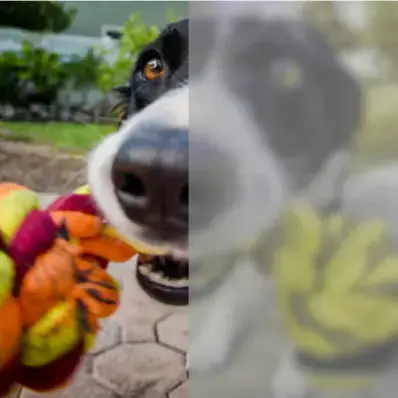What Colors Can Dogs See?
While dogs cannot see the full spectrum of colors that humans can, they are not limited to just black and white. Dogs can see shades of blue and yellow but struggle to distinguish between colors like red and green. It’s also important to monitor dog eye health problems such as cataracts, glaucoma, and dry eye.
There are two main types of color blindness:
- Red-green color blindness: Dogs with this type struggle to distinguish between red and green.
- Blue-yellow color blindness: Dogs with this type have difficulty telling the difference between blue and yellow.
For example, a bright red ball may appear as a shade of gray or brown to a dog, while green grass might look more yellowish.
Dog Vision vs. Human Vision
Dogs and humans see the world in fundamentally different ways due to variations in the structure of their eyes. In humans, the extent of color blindness depends on which color receptors in the eye are impaired.
Here’s a comparison:
- Color Perception: Humans have three types of cones, enabling them to perceive a wide range of colors, including red, green, and blue. Dogs see color with only two types of cones, and see a more limited spectrum, mainly blues and yellows.
- Light Sensitivity: Dogs have more rods in their eyes, which makes them better at detecting motion and seeing in low-light conditions compared to humans.
- Sharpness of Vision: Humans generally have sharper vision with better detail, while dogs prioritize motion and contrast over fine details.
Understanding Dog Vision
To understand whether dogs are color blind, we first need to look at how dogs’ eyes work. Like humans, dogs have specialized cells in their eyes called cones and rods. Cones in their eyes are responsible for detecting color, while rods are more sensitive to light and motion.
Humans have three types of cones, allowing us to perceive a wide range of colors, including red, green, and blue. Dogs, on the other hand, only have two types of cones. This means their color vision is similar to a condition in humans known as red-green color blindness.
How Dog Vision Affects Their Behavior?
Dogs rely more on motion, brightness, and contrast than on color. This is because they have a higher number of rods, which are excellent for seeing in low light. This adaptation makes dogs great hunters and companions in dim conditions but limits their ability to rely on color cues.
For example, a dog may spot a moving toy or an object with high contrast more quickly than one that blends into the background, even if it is brightly colored.
Does Breed Affect a Dog’s Vision?
While all dogs share similar visual structures, certain breeds may have slight differences in their vision:
- Hunting or Herding Breeds: Dog breeds like Labrador Retriever, Border Collie, Australian Shepherd, and Springer Spaniel. These traits make them excellent at tracking moving objects and performing tasks in dynamic environments.
- Brachycephalic Breeds: Breeds like Pug, Bulldog, and Shih Tzu might have a narrower field of view due to their flat facial structure. This limitation can impact their spatial awareness and ability to detect motion at the edges of their vision.
Understanding these variations can help owners tailor activities and environments to their dog’s unique abilities.
Practical Implications for Dog Owners
Understanding your dog’s vision can help you make better choices for their toys and accessories. When selecting toys, choose ones in blue or yellow shades, as these are easier for dogs to see. Avoid relying on red or green toys in grassy environments, as they may blend in and become difficult for your dog to locate.
Additionally, games and training sessions can be enhanced by using high-contrast objects that cater to your dog’s unique vision.
Myth Busting: Do Dogs See in Black and White?
The belief that dogs see the world in black and white is outdated and inaccurate. While their color vision is limited compared to humans, they can still perceive some colors. Dogs’ visual world is not colorless but muted, with a focus on blues, yellows, and grays.








